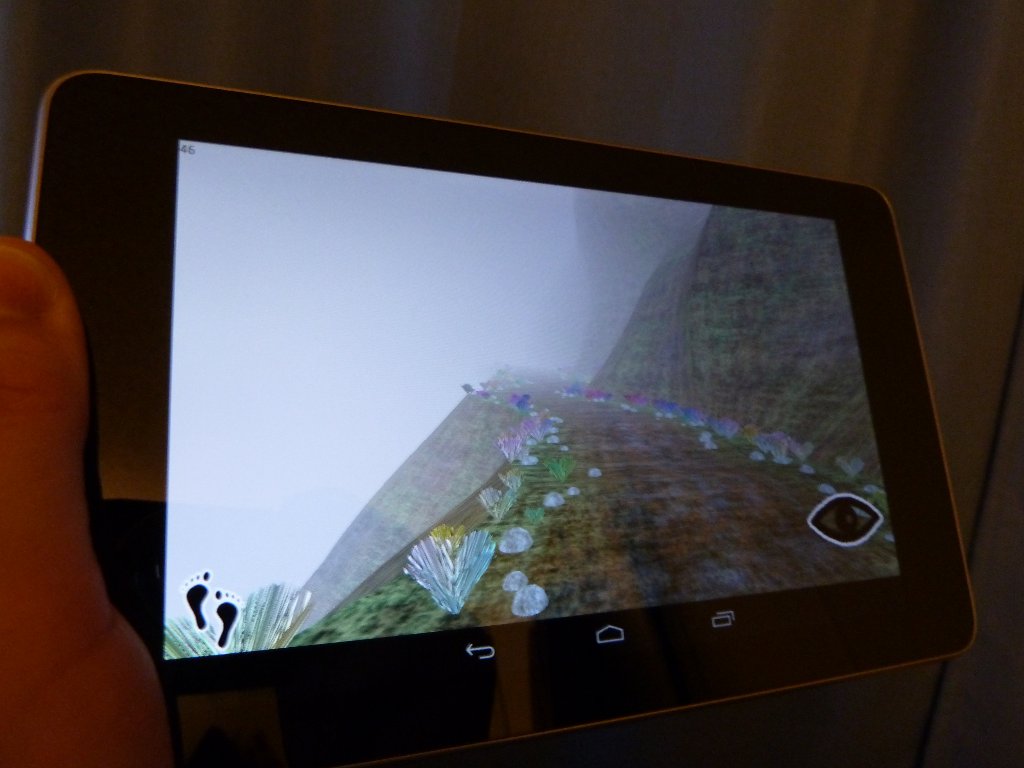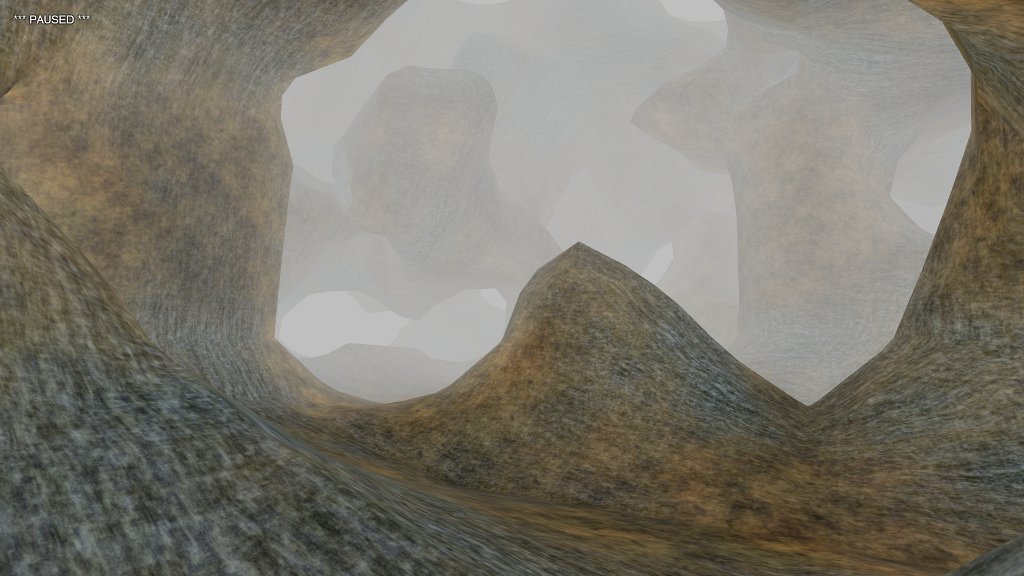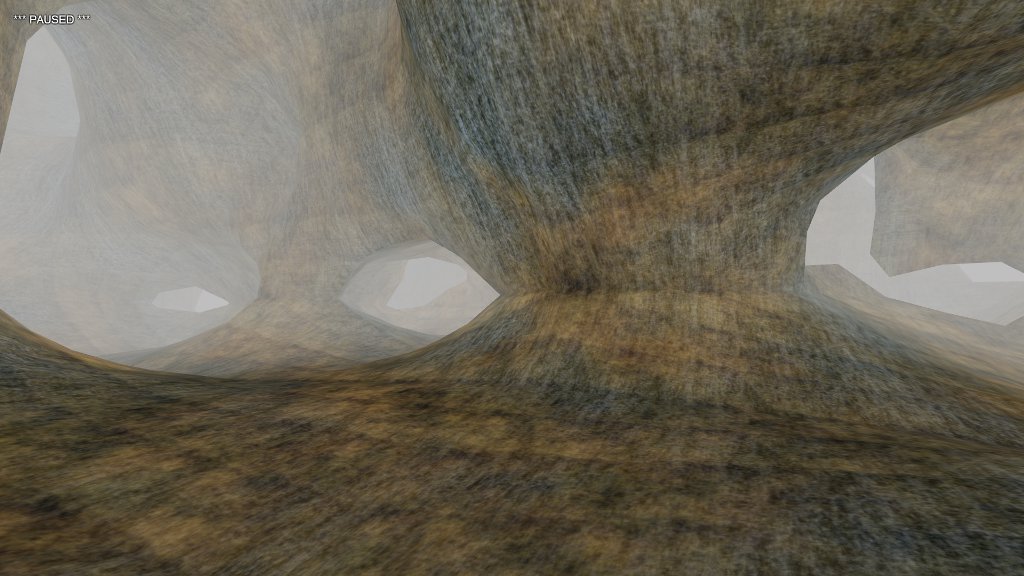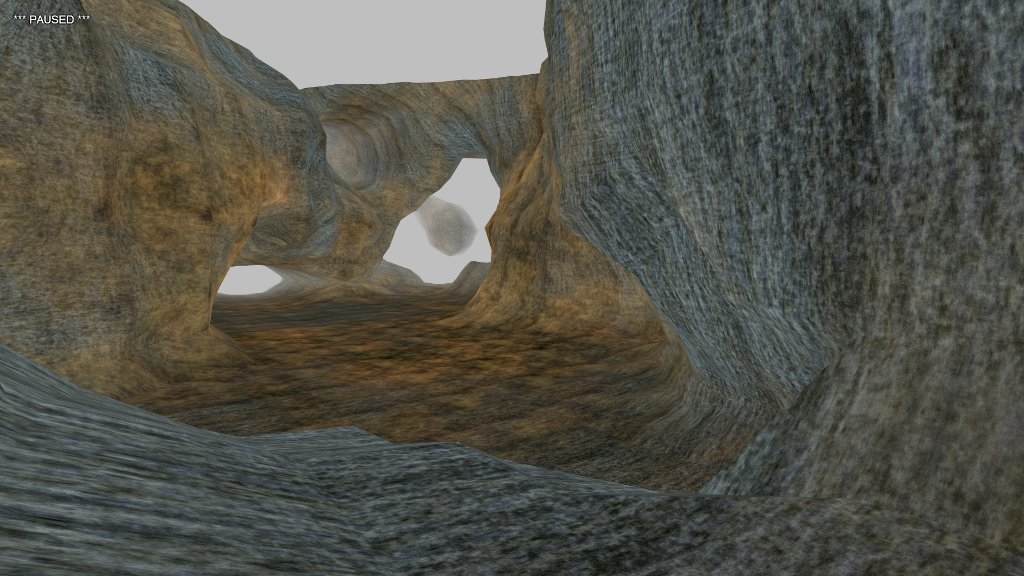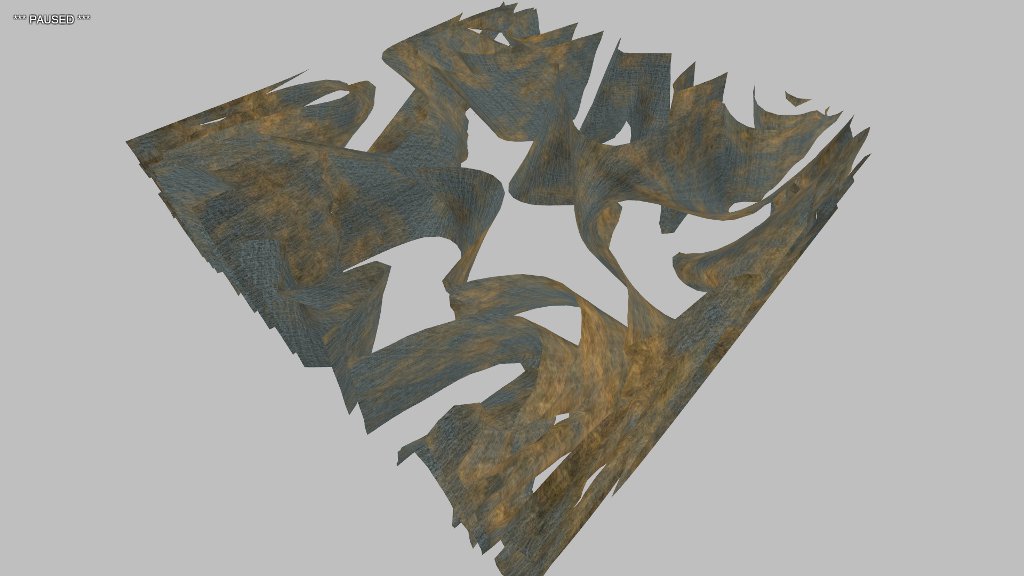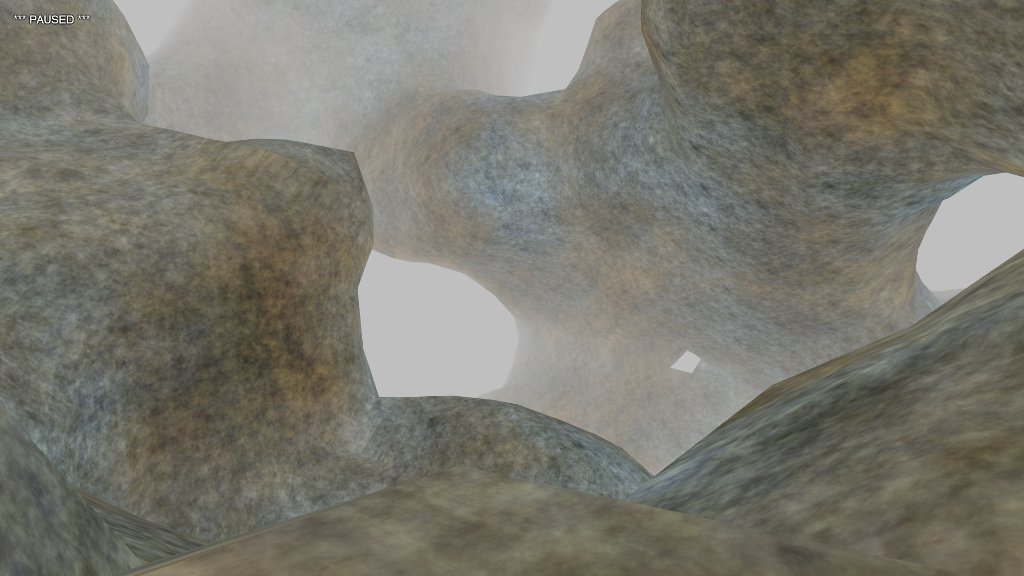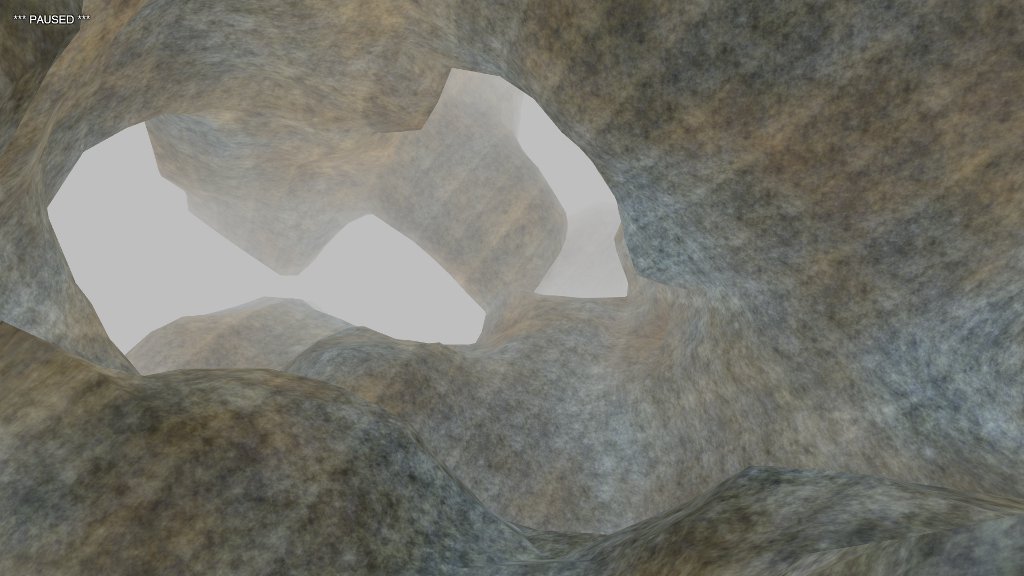Ever since Web Workers arrived, I’ve been thinking about how to use them in my own stuff. I’ve been developing a game that involves a procedurally generated cliff path and I want that path, like all good things, to go on forever.
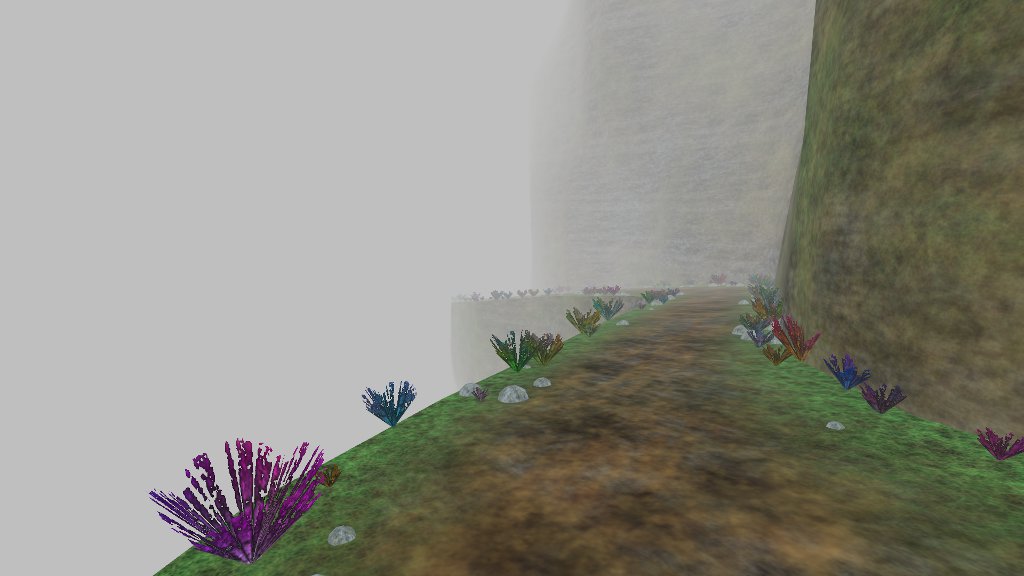
(Want to see it in action? Try the Live Demo. WSAD moves, Q for fullscreen.)
I update the scene every time the player moves a set distance from the last update. If I do this within an animation frame, I’m going to get a drop in frame rate, and possibly a visible skip in the game experience. That’s an immersion killer. Workers to the rescue!
Well, not so fast.
The GL context itself can’t be used in a worker thread, as it’s derived from a DOM object. I can’t update my display meshes directly, and I can’t send them back and forth—function members are stripped out when sending objects between threads. Only data is allowed. So: data it is. Generate updates in the worker thread, and hand the results over to the main thread for display. (I was worried that objects would be serialized JSON-style across thread boundaries, but Chrome and Firefox perform a higher-performance binary copy of the data instead.)
Creating a thread is simple enough.
T.worker = new Worker("thread.js");
T.worker.onmessage = function(e) {
T.handle(e);
};
T.worker.onerror = function(e) {
console.log("worker thread error: " +
e.message + " at line " +
e.lineno + " in file " +
e.filename);
};
Sadly, that error handler is all the debugging support you’re likely to get. Because the worker thread is running inside another page context, you can’t set a breakpoint in it. Back to the heady days of printf debugging! Ah, memories.
After creating the thread, I want to tell it to construct whatever objects it needs to fulfill my requests—in this case, the objects that describe the cliff path surfaces. There’s a problem, however, as I also need those objects in the main thread to handle collisions. I can’t share the surface objects directly as they contain function members. So, I create the surface maps, which are data-only, and ship those across.
// generate road and cliff surface maps
this.road.map = SOAR.space.make(128);
SOAR.pattern.randomize(this.road.map, T.seed(), 0, 1);
this.road.height = SOAR.space.makeLine(this.road.map, 6, 0.05);
this.cliff.map = SOAR.space.make(128, 128);
SOAR.pattern.walk(this.cliff.map, T.seed(), 8, 0.05, 1, 0.5, 0.5, 0.5, 0.5);
SOAR.pattern.normalize(this.cliff.map, 0, 1);
var surf0 = SOAR.space.makeSurface(this.cliff.map, 10, 0.05, 0.1);
var surf1 = SOAR.space.makeSurface(this.cliff.map, 5, 0.25, 0.5);
var surf2 = SOAR.space.makeSurface(this.cliff.map, 1, 0.75, 1.5);
this.cliff.surface = function(y, z) {
return surf0(y, z) + surf1(y, z) + surf2(y, z);
};
// send the maps to the worker thread and let it initialize
T.worker.postMessage({
cmd: "init",
map: {
road: this.road.map,
cliff: this.cliff.map
},
seed: {
rocks: T.seed(),
brush: T.seed()
}
});
On the thread side, a handler picks up the message and routes it to the necessary function.
this.addEventListener("message", function(e) {
switch(e.data.cmd) {
case "init":
init(e.data);
break;
case "generate":
generate(e.data.pos);
break;
}
}, false);
The initialization function uses the surface maps to build surface objects, plus a set of “dummy” mesh objects.
function init(data) {
// received height map from main thread; make line object
road.height = SOAR.space.makeLine(data.map.road, 6, 0.05);
// generate dummy mesh for vertex and texture coordinates
road.mesh = SOAR.mesh.create(display);
road.mesh.add(0, 3);
road.mesh.add(0, 2);
// received surface map from main thread; make surface object
var surf0 = SOAR.space.makeSurface(data.map.cliff, 10, 0.05, 0.1);
var surf1 = SOAR.space.makeSurface(data.map.cliff, 5, 0.25, 0.5);
var surf2 = SOAR.space.makeSurface(data.map.cliff, 1, 0.75, 1.5);
cliff.surface = function(y, z) {
return surf0(y, z) + surf1(y, z) + surf2(y, z);
};
cliff.mesh = SOAR.mesh.create(display);
cliff.mesh.add(0, 3);
cliff.mesh.add(0, 2);
// received RNG seed
brush.seed = data.seed.brush;
brush.mesh = SOAR.mesh.create(display);
brush.mesh.add(0, 3);
brush.mesh.add(0, 2);
rocks.seed = data.seed.rocks;
rocks.mesh = SOAR.mesh.create(display);
rocks.mesh.add(0, 3);
rocks.mesh.add(0, 2);
}
Creating these dummy objects might seem strange. Why not just use arrays? Well, the mesh object wraps a vertex array plus an index array, and provides methods to deal with growing these arrays and handling stride and so on. It’s more convenient and means I have to write less code. When I send the mesh object across the thread boundary, I can simply treat it as a data object.
On every frame update, I check the player’s position, and once it’s moved a set distance from the position of the last update, I tell the worker thread to get busy.
update: function() {
SOAR.capture.update();
T.player.update();
// update all detail objects if we've moved far enough
var ppos = T.player.camera.position;
if (T.detailUpdate.distance(ppos) > T.DETAIL_DISTANCE) {
T.worker.postMessage({
cmd: "generate",
pos: ppos
});
T.detailUpdate.copy(ppos);
}
T.draw();
}
The worker handles the request by populating the dummy meshes and sending them to the display thread.
function generate(p) {
// lock the z-coordinate to integer boundaries
p.z = Math.floor(p.z);
// road is modulated xz-planar surface
road.mesh.reset();
indexMesh(road.mesh, 2, 64, function(xr, zr) {
var z = p.z + (zr - 0.5) * 16;
var y = road.height(z);
var x = cliff.surface(y, z) + (xr - 0.5);
road.mesh.set(x, y, z, xr, z);
}, false);
// cliff is modulated yz-planar surface
// split into section above path and below
cliff.mesh.reset();
indexMesh(cliff.mesh, 32, 64, function(yr, zr) {
var z = p.z + (zr - 0.5) * 16;
var y = road.height(z) + yr * 8;
var x = cliff.surface(y, z) + 0.5;
cliff.mesh.set(x, y, z, y, z);
}, false);
indexMesh(cliff.mesh, 32, 64, function(yr, zr) {
var z = p.z + (zr - 0.5) * 16;
var y = road.height(z) - yr * 8;
var x = cliff.surface(y, z) - 0.5;
cliff.mesh.set(x, y, z, y, z);
}, true);
// brush and rocks are generated in "cells"
// cells occur on integral z boundaries (z = 0, 1, 2, ...)
// and are populated using random seeds derived from z-value
brush.mesh.reset();
(function(mesh) {
var i, j, k;
var iz, x, y, z, a, r, s;
// 16 cells because path/cliff is 16 units long in z-direction
for (i = -8; i < 8; i++) {
iz = p.z + i;
// same random seed for each cell
rng.reseed(Math.abs(iz * brush.seed + 1));
// place 25 bits of brush at random positions/sizes
for (j = 0; j < 25; j++) {
s = rng.get() < 0.5 ? -1 : 1;
z = iz + rng.get(0, 1);
y = road.height(z) - 0.0025;
x = cliff.surface(y, z) + s * (0.5 - rng.get(0, 0.15));
r = rng.get(0.01, 0.1);
a = rng.get(0, Math.PI);
// each brush consists of 4 triangles
// rotated around the center point
for (k = 0; k < 4; k++) {
mesh.set(x, y, z, 0, 0);
mesh.set(x + r * Math.cos(a), y + r, z + r * Math.sin(a), -1, 1);
a = a + Math.PI * 0.5;
mesh.set(x + r * Math.cos(a), y + r, z + r * Math.sin(a), 1, 1);
}
}
}
})(brush.mesh);
rocks.mesh.reset();
(function(mesh) {
var o = SOAR.vector.create();
var i, j, k;
var iz, x, y, z, r, s;
var tx, ty;
for (i = -8; i < 8; i++) {
iz = p.z + i;
// same random seed for each cell--though not
// the same as the brush, or rocks would overlap!
rng.reseed(Math.abs(iz * rocks.seed + 2));
// twenty rocks per cell
for (j = 0; j < 20; j++) {
s = rng.get() < 0.5 ? -1 : 1;
z = iz + rng.get(0, 1);
y = road.height(z) - 0.005;
x = cliff.surface(y, z) + s * (0.5 - rng.get(0.02, 0.25));
r = rng.get(0.01, 0.03);
tx = rng.get(0, 5);
ty = rng.get(0, 5);
// each rock is an upturned half-sphere
indexMesh(mesh, 6, 6, function(xr, zr) {
o.x = 2 * (xr - 0.5);
o.z = 2 * (zr - 0.5);
o.y = (1 - o.x * o.x) * (1 - o.z * o.z);
o.norm().mul(r);
mesh.set(x + o.x, y + o.y, z + o.z, xr + tx, zr + ty);
}, false);
}
}
})(rocks.mesh);
// send mesh data back to main UI
postMessage({
cmd: "build-meshes",
cliff: cliff.mesh,
road: road.mesh,
brush: brush.mesh,
rocks: rocks.mesh
});
}
Once it’s received an update, the display thread copies over the mesh data.
copyMesh: function(dest, src) {
dest.load(src.data);
dest.length = src.length;
dest.loadIndex(src.indexData);
dest.indexLength = src.indexLength;
},
build: function(data) {
this.cliff.mesh.reset();
this.copyMesh(this.cliff.mesh, data.cliff);
this.cliff.mesh.build(true);
this.road.mesh.reset();
this.copyMesh(this.road.mesh, data.road);
this.road.mesh.build(true);
this.brush.mesh.reset();
this.copyMesh(this.brush.mesh, data.brush);
this.brush.mesh.build(true);
this.rocks.mesh.reset();
this.copyMesh(this.rocks.mesh, data.rocks);
this.rocks.mesh.build(true);
}
And that’s that. Nice work, worker! Take a few milliseconds vacation time.

